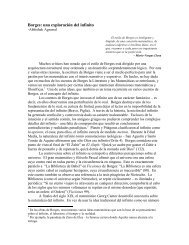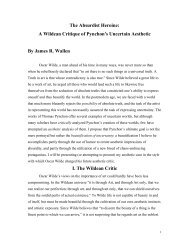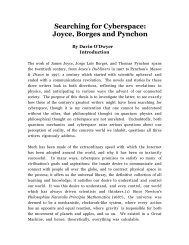And A Very Good Time It Was: A Short Life of ... - The Modern Word
And A Very Good Time It Was: A Short Life of ... - The Modern Word
And A Very Good Time It Was: A Short Life of ... - The Modern Word
You also want an ePaper? Increase the reach of your titles
YUMPU automatically turns print PDFs into web optimized ePapers that Google loves.
At the insistence <strong>of</strong> Beach and Joyce (and to the aggravation <strong>of</strong> Joyce scholars since), the<br />
printer was rushed into finishing the typo-ridden first edition <strong>of</strong> Ulysses, so that three copies<br />
would arrive in Paris on Joyce’s fortieth birthday. Reviews began coming in, at first from familiar<br />
names. Eliot, in the Dial, wrote that “manipulating a continuous parallel between<br />
contemporaneity and antiquity” has “the importance <strong>of</strong> a scientific discovery.” Virginia Woolf<br />
later remembers him asking, “How could anyone write again after achieving the immense prodigy<br />
<strong>of</strong> the last chapter?” 164 <strong>The</strong>re were naturally those who detested the book, and those (Gertrude<br />
Stein among them) simply jealous <strong>of</strong> the attention the book was getting, but Joyce never cared to<br />
counter any <strong>of</strong> it. Probably he had been thinking about and writing it for so long that he wanted to<br />
forget it. This was the case with the technique that made the book: to those who were critical <strong>of</strong><br />
the interior monologue, he wrote indifferently that “it has served me as a bridge over which to<br />
march my eighteen episodes, and, once I have gotten my troops across, the opposing forces can,<br />
for all I care, blow the bridge sky-high.” 165 Yeats later admitted that he had never been able to<br />
finish the book, Hemingway thought it “goddamn wonderful,” 166 and his brother Stanislaus<br />
thought it a “merely technical monstrosity.” 167 While Joyce was a celebrity (he was forced to stop<br />
going to his usual restaurants), in many ways his fate was the same as his books: he was more<br />
talked about than known, which explains why, when Lucia fell ill a decade later, some seriously<br />
concluded that the author <strong>of</strong> such a “dirty” book could himself only be a dirty man, and wondered<br />
if incest hadn’t caused her to go mad.<br />
In July he and Nora went to England so he could undergo another eye surgery, and while<br />
there met Miss Weaver for the first time. When asked what he was to write next, he told her, “I<br />
think I will write a history <strong>of</strong> the world.” 168 On March 11, 1923, he wrote to her, “Yesterday I<br />
wrote two pages—the first I have written since the final Yes <strong>of</strong> Ulysses.” 169 <strong>It</strong> would take him the<br />
next sixteen years to come to the end <strong>of</strong> it.<br />
By then he already knew the title <strong>of</strong> the book was to be Finnegans Wake, a secret he divulged<br />
only to Nora. <strong>The</strong> title itself is indicative <strong>of</strong> Joyce’s ideals: he has taken a famous but otherwise<br />
common drinking song about the wake <strong>of</strong> Tim Finnegan, a working-class bricklayer who fell<br />
from his ladder (falls are everywhere in the Wake), and, by simply removing the apostrophe in<br />
Finnegans, created the “pregnant ambiguity” 170 that pervades the entire book: “it referred both to<br />
the hod carrier <strong>of</strong> the ballad, who was miraculously resurrected by the whisky at his wake, and to<br />
the tough, vegetable recurrence <strong>of</strong> human life and misbehaviour. <strong>The</strong> book was to combine the<br />
affirmation <strong>of</strong> life, which he had always defined as the central function <strong>of</strong> literature, with the<br />
scepticism about particular living beings which had always been natural to him.” 171<br />
Behind its 628 pages and mixtures <strong>of</strong> up to seventy languages, it still rests on its structure and<br />
basic characters. Separated into four parts, it mirrors (among others) the four evangelists and the<br />
four gospels, the four points (and the circle) <strong>of</strong> the compass. Part one has eight chapters, part two<br />
and three have four chapters, and part four only one. <strong>It</strong> ends in the middle <strong>of</strong> a sentence:<br />
A way a lone a last a love a long the 172<br />
and begins in the middle <strong>of</strong> the same one:<br />
riverrun, past Eve and Adam’s, from swerve <strong>of</strong> shore to best <strong>of</strong> bay, brings us by a commodius<br />
vicus <strong>of</strong> recirculation back to Howth Castle and Environs. 173<br />
Joyce takes his four parts from the <strong>It</strong>alian historiographer Giambattista Vico’s New Science,<br />
which separated history into four ages: theocratic, aristocratic, democratic, and the chaos that<br />
comes and which returns us to the beginning. However, Joyce didn’t believe in these cycles<br />
literally “beyond using them for all they are worth.” 174 Vico also believed that the sound <strong>of</strong><br />
thunder (this must have been hard for Joyce to go along with) represented to early humanity the<br />
voice <strong>of</strong> God, and the spark <strong>of</strong> human thought and consciousness. Ten times during the Wake<br />
there are words 175 100 letters long (the last being 101), each taken from dozens <strong>of</strong> words for





